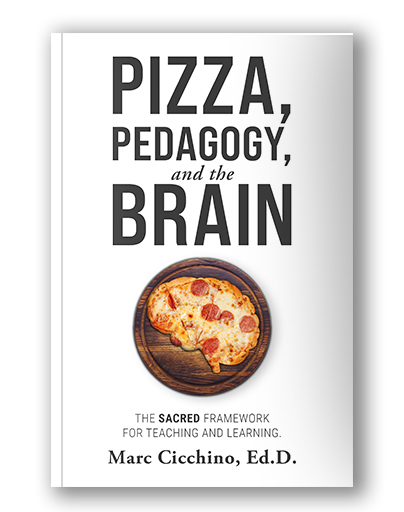If you’re looking for examples of brain based learning activities that you can put to work right away, you’ve come to the right place. Below, you’ll find a number of awesome brain based learning activities organized by the six SACRED principles of brain based learning.
To learn more about the brain based principles themselves, or for a deeper dive into even more examples of brain based learning activities, check out the book Pizza, Pedagogy, and the Brain — or, if you’re looking for more flexible online PD, check out the online course! Likewise, if you’re after empirical research direct from the source, two peer reviewed journals that are worth checking out are Educational Neuroscience and Mind, Brain, and Education.
Examples of brain based learning activities
The examples of brain based learning activities below are organized using the six SACRED principles: Safety, Attention, Connection, Retrieval, Executive Function, and Differentiation.
Safety: Keep the amygdala in check
- Offer students the opportunity to volunteer. One of the most common ways that students’ feelings of safety are compromised in the classroom is with the threat of being called on at random. The sense of being potentially caught unaware, or unprepared, or simply thrust into the spotlight in a potentially embarrassing way in front of peers, is more than enough to disrupt the meaningful learning process.
- Offer students the option to revisit their work. This is an especially powerful strategy if students are feeling high pressure to perform or experiencing academic anxiety from forces such as a school’s culture or parental pressures.
- Offer students control. A sense of control is the closest thing we’ve got to a silver bullet when it comes to overcoming stress. With that in mind, consider how students can be given control over multiple facets of their experience in your class — from where they’re sitting to how they participate.
Attention: Piercing the attention filter
- Embrace the absurd. You might feel like a goofball, and there’s a good chance you’ll be memorialized in the school yearbook for it, but what better way to pierce the attention filter than by embracing the absurd with costumes, novelty, and generally surprising students with the unexpected.
- Use audio and video to your advantage. Social media platforms and video games lean into audio and video because they know it has powerful implications for capturing and sustaining engagement. Borrow this page from their playbook, and use both audio and video to bring your classroom content to life.
Connection: Making learning more memorable
- Pretest for prior knowledge. Pretests are often used by teachers to get a baseline understanding of what students know, but did you know that pretests have been shown to strengthen future learning? In short, they create a foundation for students’ brains that can be more readily built upon as the new content is introduced, as opposed to students who have never been pre-tested and therefore lack that foundational context for connection.
- Leverage students’ interests. Prior knowledge doesn’t necessarily mean content-specific prerequisites. Students’ interests can provide meaningful frameworks for understanding the new content being learned in class. Teaching advanced physics concepts with the context of skateboarding, golfing, or even playing Angry Birds, can do wonders.
Retrieval: Reinforcing memories for retention
- Mix up your tests. Don’t leave the content that was assessed in Chapter 1 in the dust. Instead, revisit it often. Integrate that content into classroom activities (even if on an irregular basis, spaced weeks apart) throughout the school year. Mix up your tests by integrating questions from prior assessments, even if they’re not for credit. Without revisiting that content, it’s sure to fade — but with spaced and interleaved integrations throughout the year, it will be stronger than ever.
- Leverage timing. It turns out that timing matters — a lot. Don’t hesitate to allow some time to pass before revisiting or reinforcing concepts that were previously introduced to students. A week or two can provide the essential time necessary for their brains to consolidate the material that was initially introduced — and, what’s more, the retrieval of that content once it has become “rusty” has been shown to reinforce its place in memory.
Executive Function: Scaffolding the necessary skills for success
- Set reminders and alerts. Depending on students’ ages and maturity levels, you might remind them to set alerts for themselves, or you might set alerts for them (using apps like Remind, or via scheduled email blasts). The part of the brain responsible for these kinds of executive function skills isn’t fully mature until the mid-twenties, so scaffolds like reminders and alerts are critical in K-12 and beyond.
- Scaffold organization anywhere and everywhere. Unless you’re actually testing students for their ability to organize themselves, it can be incredibly beneficial to scaffold their organizational processes so that they (and you) can focus on the target learning goals. Equip students with an agenda or schedule. Provide graphic organizers and calendars. Don’t shy away from sharing these supports so you can get to the heart of your lesson’s intended learning outcomes.
Differentiation: Personalize what matters most
- Differentiate for any of the brain based strategies described above. It’s true that our brains are largely wired in similar ways. (We aren’t left-brained or right-brained… that’s a myth!) But it’s just as true that every student brings an entirely unique life experience into the classroom. Their prior knowledge, their interests, their upbringing, and even their experience at home before school, is surely to vary from student to student. Instead of brushing this off, leverage it to personalize learning for every student in the room.
Beyond examples of brain based learning activities
As mentioned earlier, you can learn more about the six brain based principles themselves in the book Pizza, Pedagogy, and the Brain — or, if you’re looking for more flexible online PD, check out the online course!

